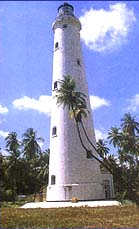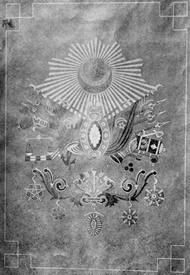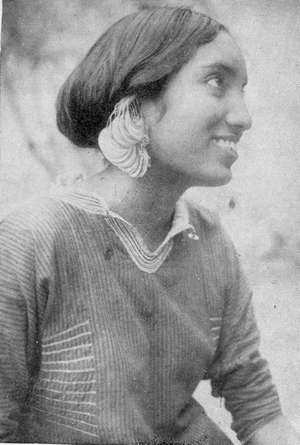According to Ellen Kattner, oral tradition has
it that Kamboranin and Kohoratukamana (Click
to see note), two princesses from the Maldives, came to Minicoy.
When they arrived, the tivaru, who had been living there
before, left the island for Sri Lanka. Their descendants form
the aristocracy of Minicoy. The lower classes are made up of the
descendants of their crew.
 Minicoy
Lighthouse
Minicoy
Lighthouse
|
It is unclear when Minicoy came to be grouped
with the Laccadive Islands now known as Lakshadweep. The term
Lakshadweep means a hundred thousand islands. The Laccadive group
consists of only 25 islands and it is unlikely the name refers
to a numerical value. It is possible that the term originally
applied to the Laccadive-Maldive-Chagos archipelago. Even then
the number of islands is only around 2000.
The kings of the Maldives styled themselves
as "Kings of Twelve Thousand Islands". This indicated
a huge number rather than a numerical value. In the old Maldive
duodecimal system of counting, twelve thousand was a round figure
such as a hundred thousand in the decimal system. Clearly, therefore,
twelve thousand was the figurative duodecimal equivalent of the
decimal a hundred thousand. Even today in Maldive and Minicoy
speech, terms such as "lakka duvas" (a hundred thousand
days) are used to refer to a huge number- in this case, a huge
number of days. (click to see note)
 The
coat of arms of the Ali Raja of Cannanore
The
coat of arms of the Ali Raja of Cannanore
|
Until the 16th Century, the Laccadives
appear to have been under the suzerainty of the Kolthari Raja
of Chirakkal in what is now the Indian state of Kerala. With the
Portuguese ascendancy in the region, it became necessary for the
Kolthari to transfer sovereignty of the islands to their hereditary
admiral, the Ali Raja of Cannanore. It is unclear if Minicoy was
included in this transfer or if in fact Minicoy ever formed part
of the dominons of the Kolthari.
Until relatively recently, the kings and queens
of the Maldives issued edicts addressed to the subjects in their
realm "Malikaddu Midhemedhu". This meant "Between
Minicoy and Addu". Addu was the Southern-most island in the
dominions of the Maldive kings and was in Addu Atoll. The island
was dredged off by the British in 1959 to construct the airfield
on neighbouring Gan island. As late as AD 1696, a grant issued
under the Seal of the King Siri Kula Ran Mani of the Maldives
referred to him as "Malikaddu Midhemedhu ekanuonna mi korhu
anikaneh nethee korhu" which meant "Sole Sovereign with
no other over what lies between Minicoy and Addu". The grant
was issued in the matter of the building and upkeep of a mosque
in the island of Finey in Thiladhummathi Atoll.
|
 Athiri Ganduvaru Baugey Khadija Manika
Athiri Ganduvaru Baugey Khadija Manika
(click here to view
Khadija Manika's genealogy)
Khadija
Manika, an aristocratic lady, is wearing a traditional
Minicoy-Maldive women's costume. Khadija Manika is also
a descendant of the Maldive Royal family, the House of
Hilaaly and Huraagey.
According
to ibn Batuta, only the feyli wrap-around used
to be worn from the waist down. The gown was a compromise
with Islam evolved a few centuries after the conversion.
There was much resistance to imported foreign concepts
of modesty.
Click
to read more.
|
On December 18, 1790 Minicoy was surrendered
to the Court of Directors of the English East India Company by
the Ali Raja of Cannanore, Junumabe Ali-Adi Raja Bibi II. The
Ali Raja was allowed to administer Minicoy in return for a tribute
to the East India Company. She continued to dispute the transfer
of sovereignty but in 1824, her successor, Mariambe Ali-Adi Raja
Bibi made a formal written recognition of the suzerainty of the
East India Company. She and her successors, however, continued
the tributary arrangement.
On 27 July 1795, the Governor General of the
Presidency of Madras under whose jurisdiction Minicoy was, abolished
Junumabe Ali Adi-Raja Bibi's coir monopoly. This was the beginning
of the end of the Ali Raja's real control over Minicoy.
n 1857, suzerainty over Minicoy transferred
from the East India Company to the Indian Empire when Queen Victoria
was proclaimed Empress.
In 1905 under the heavy burden of debts to the
Empire, Mohamed Ali-Adi Raja agreed to surrender sovereignty and
control over Minicoy. He died before the formal transfer. After
an attempt to back track, his successor Imbicchi Ali-Adi Raja
Bibi finally signed over Minicoy to the Emperor Edward VII on
9 February 1909, back dated to 1 July 1905. Following this, Minicoy
was annexed to the District of Malabar.
|
A Hero
in Time?
Uteem
Mohamed Thakurufan and his band of rebels took
up arms against their king (Siri Dhirikusa Loka Hassan
IX later known as Manoel) who had converted to Christianity.
They made Minicoy their base while making raids on islands
under the sovereign authority of their king. Thakurufan
was an agent of the Ali Raja of Cannanore. The nature of
the relationship between Mohamed Thakurufan and the Ali
Raja of Cannanore was outlined in a letter sent by a later
Ali Raja, Mariambe Ali-Adi Raja Bibi, to the Sultan Mohamed
Mueenuddine I of the Maldives. The letter was dated Friday
17 Jamada-el-oula Anno Hegirae 1243 (7 December AD
1827). According to the letter Mohamed Thakurufan had entered
into a treaty ceding sovereignty of the Maldives to the
Ali Raja of Cannanore in the event Thakurufan was established
in power in Male. (refer page 294 of Divehi Tarikh).
A reply was sent from Malè explaining that Thakurufan
had no legal authority to enter into such a treaty with
the Ali Raja of Cannanore. (see also Myth
of Portuguese Rule)
|
n August 1947 the possessions of the Emperor
of India passed to either the Indian Union or Pakistan according
to an agreed demarcation line. The rulers of the independent countries
that were vassals of the Emperor had the choice of acceding to
either India or Pakistan.
While Minicoy was a sovereign possession of
the Emperor and not that of an independent country such as Cannanore,
Kashmir or Hyderabad, it is unclear why India felt it necessary
to hold a plebiscite in Minicoy in 1956 to determine whether or
not the people of Minicoy wished to join the Indian Union.
On 1 November 1956, India formally annexed Minicoy
and incorporated it into the Union Territory of Laccadive Minicoy
and Amindivi Islands, renamed Lakshadweep in 1973

